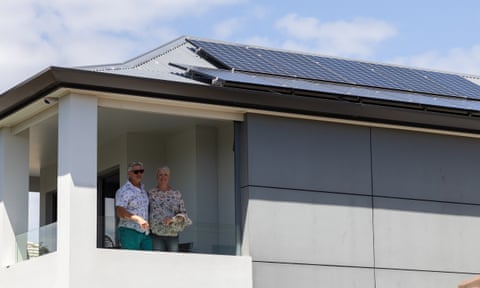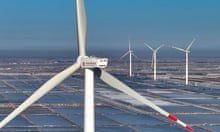For a brief period over several weekends this spring, the state of South Australia, which has a population of 1.8 million, did something no other place of a similar size can claim: generate enough energy from solar panels on the roofs of houses to meet virtually all its electricity needs.
This is a new phenomenon, but it has been coming for a while – since solar photovoltaic cells started to be installed at a rapid pace across Australia in the early 2010s. Roughly one in three Australian households, more than 3.6m homes, now generate electricity domestically. In South Australia, the most advanced state for rooftop solar, the proportion is nearly 50%.
No other country comes close at installing small solar systems on a per capita basis. “It’s absolutely extraordinary by world standards,” said Dr Dylan McConnell, an energy systems analyst at the University of New South Wales. “We’re streets ahead.”
There was no overarching plan that made Australia the world leader in household solar PV. Analysts mostly agreed that it was a happy accident, the result of a range of uncoordinated policies across tiers of government. Many were subsidy schemes that were derided as too generous and gradually scaled back, but the most important – an easy-to-access, upfront national rebate available to everyone – endured. It has helped make panels cost-effective and easy to install.
Cost was a big consideration for the Jamiesons – Sean, Deb and their 19-year-old daughter, Molly – when they installed a system on the four-bedroom house in a beachside suburb in South Australia’s capital, Adelaide, a decade ago. They upgraded to a larger 8kW system during a home renovation five years later, and have installed two batteries, the first subsidised as part of a state government scheme trialling household energy storage systems to help stabilise a power grid that increasingly runs on variable solar and wind power.
Sean Jamieson, a pilot with the airline Jetstar, said the setup had been “incredibly beneficial”, in part because his family uses a range of energy-hungry equipment, including a pool and hot tub. They first opted for solar after watching the price of grid electricity rise sharply, mainly due to the cost of rebuilding electricity transmission poles and wires. He said it has continued to make sense.
“I’m looking at paying it off [through savings on what annual power bills would otherwise have been] in three or four years, so it’s been a great investment,” he said of the household energy system. “Generally, solar is just a no-brainer in South Australia. We’ve got a lot of sunshine and the most expensive electricity in Australia, and in the beginning it was heavily subsidised.”

Dr Gabrielle Kuiper, an independent energy and climate change strategist, noted Australia was not the first country out of the gate on rooftop solar – that was Germany, which introduced the first subsidy scheme, and “none of us would be here without them” – but said it was one of the first to capitalise on the German model. It began with a natural advantage: more sun than nearly any other wealthy country. Even the southern island state of Tasmania is at a latitude that would place it level with Spain and California if it were in the northern hemisphere.
Kuiper said Australia had succeeded at solar for reasons beyond geography. Incentives were a big part of it, but the technology’s rise was accelerated by ordinary people embracing it to have some control over their power bills and, in some cases, play a small part in tackling the climate crisis by reducing the country’s reliance on coal.
The subsidies initially included a national rebate of A$8,000 for a small 1kW array – more than the sticker price in parts of the country. It was complemented by state government feed-in tariff schemes that paid households for the energy they fed back into the power grid and, in some cases, for all the electricity they generated.
There was little planning in how the various incentives fit together and critics attacked it as an expensive and inefficient way to cut greenhouse gas emissions. But it kickstarted an industry of installers, sales people, trainers and inspectors, and quickly made solar a viable option for people beyond the country’s wealthiest suburbs.
Today, the feed-in-tariffs have been cut, but the national rebate scheme survives, with bipartisan support despite deep divisions over other responses to the climate crisis. Analysts and industry players have praised its elegant design. The rebate is processed by and paid to the installer. The buyer may not even know it exists. It is reduced by about 8% each year, a rate that roughly keeps pace with the continuing fall in the cost of having panels installed.
after newsletter promotion
The fall in cost has been significant. The sums vary depending on geography, but the SolarQuotes comparison site suggests many Australians can get a 6kW solar system for about A$6,000 (£3,100). The panels are likely to have paid for themselves within five years.
The influx of solar has brought challenges, including how to manage the flood of near-free energy in the middle of the day that risks making inflexible coal generators unviable before the country is ready for them to be turned off. Some states have responded by curtailing how much can be accepted into the grid, but Kuiper says this can be addressed through increasingly creative management. Answers include improving incentives for household batteries and fostering a two-way energy exchange between the grid and a growing electric vehicle fleet.

Rooftops provided 11% of the country’s electricity over the past year, part of a 38% total renewable energy share. The Australian government has set a challenging national goal of 82% of all electricity coming from renewables by 2030.
Simon Holmes à Court, a longtime clean energy advocate and convener of the political fundraising body Climate 200, said it was clear rooftop solar was playing a bigger part in reaching that than many people expected. “Not long ago renewables sceptics laughed at rooftop solar’s ‘tiny’ contribution. These days there’s no question solar is playing a major role in pushing coal out of our grid,” he said.
Tristan Edis, an analyst with the consultants Green Energy Markets, said the lesson for those watching on was pretty simple: the generous early subsidies worked. “It really was this fortuitous accident that happened,” he said. “The message from it is pretty clear: go hard and go big, or don’t bother.”









